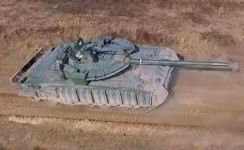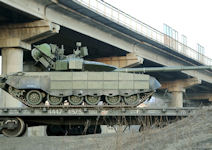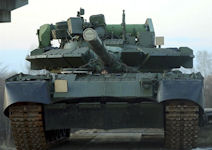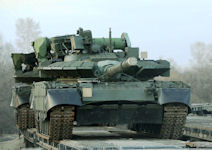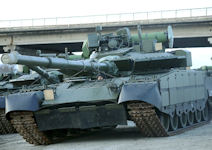T-80 Tank - Variants
The T-80B and -BV variants are often misidentified as T-80. They are visibly different and bear other distinctions, such as T-80B/-BV capability for launching AT-8/ Songster ATGM.
- T-80: The first production model of the T-80 entered production in 1978 with only a few hundred built before production switched to the T-80B.
- T-80B: Sometimes referred to Beryoza (Birch Tree), this first major redesign features a modified turret with new composite K ceramic armor providing better protection against APFSDS kinetic energy penetrators.
- T-80BK: Command version with additional communications equipment and antennae.
- T-80BV: Variant has first generation explosive reactive armor [ERA] mounted. This variant is more likely for encounter by US forces. A late production version has a new turret similar to the T-80U but fitted with the turbine engine and first generation ERA.
- T-80U: First observed in 1989 and referred to by NATO as the SMT (Soviet Medium Tank) M1989. The new turret has an improved frontal armor package with second generation explosive reactive armor. This version is equipped with the 9K120 Svir (AT-11 Sniper) laser-guided anti-tank missile in place of the older Kobra. Other improvements include a more powerful and fuel efficient gas turbine engine (GTD-1250, developing 1250 hp).
- T-80UD: Version produced in Ukraine with a 1000-hp diesel engine instead of the turbine engine, and 1st generation ERA. In August 1996 Pakistan placed an order for 320 T-80UD MBTs under a deal worth about $580 million, and the first 15 were delivered in February 1997.
- T-80UK: Command version with R-163-50K and R-163-U radios, TNA-4 land navigation system, and an electronic fuze-setting device that permits use of Ainet Shrapnel Round. The AGAVA thermal sight provides a 2,600-meter night acquisition range.
- T-80UM: Upgraded with a gunner's thermal sight with additional tank commander viewing screen. Similar to standard T-80U, but without IR searchlight and with enlarged night sight housing. Outfitted with 2nd Generation ERA.
- T-80UM1 "Bars" (Snow Leopard) : Prototype with Shtora and Arena defensive systems, though apparently without Kontakt-5 reactive armor tiles on its turret, since the Arena system with fragmentation charge launchers arranged in a semicircle around the turret front may preclude mounting reactive armor.
- T-80UM2? "Black Eagle" : Features a new turret with highly sloped front and a bustle-mounted autoloader on a standard T-80U hull. Also incoporates a redesigned ammunition storage scheme to reduce vulnerability to ammunition fires. It is unclear whether this is simply a technology testbed demonstrator vehicle, possibly intended mainly for export, or whether it may enter Russian service in stead of the new Uralvagonzavod design.
- T-84: Recent Ukrainian upgrade of T-80UD with a welded turret, a French ALIS thermal sight, a more powerful engine, optional use of ARENA active protection system (APS) and SHTORA-1 active IR ATGM jammer system. Prototypes have been demonstrated, and the tank is available for export. Ukraine's Kharkov Malyshev Plant's T-84UD main battle tank is a Ukrainian-produced version of the old Soviet T-80 design. The Ukrainian factory, that has a pedigree for tank production dating back over 50 years claimed the first major export success for the T-80/84 in 1998 when it sold 320 to Pakistan. The Ukrainian version of the tank has a different power plant to the Russian T-80UD and a number of other differences.
T-80BVM is the latest modification of the T-80 tank, which was initially developed in 1976. This version of the Russian medium tank received top-tier "Relikt" explosive reactive armor, improved Sosna-U gunner sight (which is also used in Russian T-90s) and upgrades to various systems, including the engine The modernisation of the tank, last upgraded in 1985, has allowed it to be armed with kinetic energy anti-tank rounds made of depleted uranium. The latter increases the density of the round's material, making it more effective against steel armor. The Russian Defence Ministry has published specifications for the latest model of Russia's T-80 tank (named T-80BVM) developed in 2017. It turned out that the tank has received a new auto-loader, allowing it to use new anti-tank ammo: Svinets-1 and Svinets-2 rounds. Although little is known about these rounds, reports suggest that one of them is made of an alloy, based on depleted uranium. Such rounds are not forbidden by any international convention, and their usage has been deemed relatively harmless since radioactive emissions from such rounds is minimal due to depleted uranium's significant half-life.
The T-80BVM turret of the main battle tank (OBT) will receive the Relic dynamic protection kit, and a new set of dynamic dynamic attachments will also be placed in soft containers on the sides of the tank. It was reported that previously only T-72B3 tanks of the 2016 model had such protection. Thus, there is now reason to believe that after the T-80BVM and T-72B3 new armor will lbe on other combat vehicles of the Russian army, including, for example, on the T-90M.
The new ‘soft packages’ offers major improvements in capabilities compared with standard bricks. The tank soft kit is a durable fabric package, attached by belts on the main side armor at a distance of 10-15 centimeters. Inside these ‘packages’ are exactly the same elements of explosive reactive armour as usual. Moreover, the soft ERA (exactly as it is called in Russia) is hung only on the sides of the armored vehicle, while all the same ‘bricks’ are used on the turret and frontal armor. The main reason for the use of soft ERA is that in urban environments, it is necessary for a tank to come into contact with any solid surface (a corner of a building, walls) the elements of a classic ERA are torn off the sides, leaving unprotected areas. Soft ERA in this regard is better, though small, and can survive such a collision. If not, it doesn’t matter. It is possible to hang a new ‘packages’ in a matter of seconds, while the bricks are holding onto bolts and in order to replace them will have to remove the damaged element and reinstall the new one.
In 2020 Russian tank manufacturer UVZ corporation received an additional order on the modification of the T-80BVM, and arm it with some of the latest tank weaponry used on the T-14 ‘Armata’ tanks. As stated by the Defense Ministry, the army’s initial order is 50 units and will be increased if the ministry is satisfied with the result.
|
NEWSLETTER
|
| Join the GlobalSecurity.org mailing list |
|
|
|


